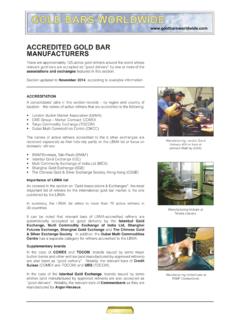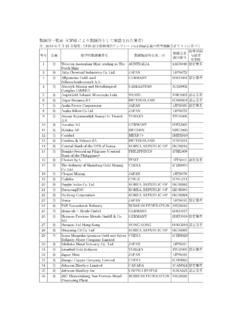Transcription of THE PRECIOUS METALS INDUSTRY IN SWITZERLAND'S …
1 THE PRECIOUS METALS . INDUSTRY IN SWITZERLAND'S . ECONOMY. Olivier Cadot Dyai Conde December 2013. 1. Contents Executive 3. 1 Introduction .. 5. 2 Understanding the global gold market .. 5. A highly dynamic, high-potential export market .. 5. with strong governance mechanisms .. 11. 3 PRECIOUS METALS refining in SWITZERLAND'S economy .. 12. The economics of PRECIOUS - metal refining .. 12. PRECIOUS - metal refining's contribution to the Swiss economy .. 13. 4 SWITZERLAND'S recipe for success : A unique industrial cluster .. 15. 5 Conclusions .. 17. References .. 18. 2. Executive summary PRECIOUS - metal refining is a Swiss success story, drawing on the country's competitive strengths and contributing back to its wealth. Its success rests on a regulatory framework that has grown increasingly effective in recent years and put Swiss producers in the position of standard-setters of the profession and global referees in the international gold market.
2 It also rests on underlying competitive assets including tight management, innovation, a skilled workforce, and linkages to downstream sectors including watch-making, jewelry, and banking. The PRECIOUS - metal refining sector contributes to SWITZERLAND'S national wealth, generating over 1'500 direct jobs and another 1'000 indirectly. These are quality jobs , leveraging skills and paying wages substantially above the manufacturing average. The INDUSTRY also contributes directly CHF 29 million in corporate income tax and, indirectly, another 10 million through employee income taxes. SWITZERLAND'S position in the global gold market is strategic as gold has strong growth potential worldwide. It is a superior good whose demand rises more than proportionately with consumer wealth; at the same time, it serves as store of value during periods of uncertainty, making it less vulnerable to economic downturns. It has dynamic demand in two of the world's largest and fastest- growing emerging markets, India and China, which together account for close to 60% of world gold demand (although they account for less than a fifth of global GDP).
3 This positive market orientation makes SWITZERLAND'S position portent of future growth and job creation. The gold market has also substantially improved its self-regulation over the years, and some of SWITZERLAND'S refiners have been leaders in the sector's emerging global governance, thanks to their analytical capabilities and reliance on a national regulatory system that is itself global best practice. SWITZERLAND'S regulatory system dates back from the 1880s and has evolved in steps throughout the XXth century. Its strength derives from original features like the essayeur jur profession a body of quality inspectors who are legally responsible for their assessments and its oversight of refineries. Together with watch-making and banking, PRECIOUS - METALS refining forms a cluster of activities that have carved for themselves a global leadership position. The success of SWITZERLAND'S banking and watch-making industries is well known.
4 The success of its PRECIOUS - metal refiners and their critical contribution to the cluster's overall competitiveness is less known. In the watch INDUSTRY , where Swiss-made products dominate the market's upper segment, PRECIOUS METALS , according to a recent market study, have the most dynamic demand. The availability of domestically-refined gold enhances the ability of domestic producers to claim the Swiss-made label and to respond to demand swings. Similarly, the ability of banks to put on the market, with their stamp on it, Swiss-made gold bars of guaranteed quality and title contributes to the attractiveness of their gold-trading activities, which can account for up to 10% of forex profits. Without local refiners, they would have to procure gold from foreign producers, forsaking the competitive advantage conferred by SWITZERLAND'S PRECIOUS - METALS legal framework. The creation of successful clusters of export-oriented activities, positioned on dynamic and high- quality segments of global markets, is the objective of every industrial-policy plan in every country.
5 Very few such plans succeed. Clusters emerge only progressively and may take decades to reach maturity, beyond the typical horizon of policymakers. Moreover, the recipe for success is elusive as 3. INDUSTRY clusters react only weakly to standard industrial-policy instruments like tax incentives, technical assistance, or export promotion. If clusters are difficult to create, they are easy to destroy. Because of their complexity, they are vulnerable to entropy and can collapse if one of their pillars weakens. The place of PRECIOUS - metal refining in SWITZERLAND'S gold cluster is critical in this regard. 4. 1 Introduction PRECIOUS - metal refining is a Swiss success story, drawing on the country's competitive strengths and contributing back to its wealth. Its success rests on a regulatory framework that has grown increasingly effective in recent years and put Swiss producers in the position of standard-setters of the profession and global referees in the international gold market.
6 It also rests on underlying competitive assets including tight management, innovation, a skilled workforce, and linkages to downstream sectors including watch-making, jewelry, and banking. The PRECIOUS - metal refining sector contributes to SWITZERLAND'S national wealth, generating over 1'500 direct jobs and another 1'000 indirectly. These are quality jobs , leveraging skills and paying wages substantially above the manufacturing average. The INDUSTRY also contributes directly CHF 29 million in corporate income tax and, indirectly, another 10 million through employee income taxes. Together with watch-making and banking, PRECIOUS - METALS refining forms a cluster of activities that have carved for themselves a global leadership position. The success of SWITZERLAND'S banking and watch-making industries is well known. The success of its PRECIOUS - metal refiners and their critical contribution to the cluster's overall competitiveness is less known.
7 In the watch INDUSTRY , where Swiss-made products dominate the market's upper segment, PRECIOUS METALS , according to a recent market study, have the most dynamic demand. The availability of domestically-refined gold enhances the ability of domestic producers to claim the Swiss-made label and to respond to demand swings. The combination of a tight, well-designed regulatory framework, close contacts between key operators all along the value chain, and strong within-firm competitive assets (management and skills) is the archetype of a successful industrial cluster. However, as in all complex systems, entropy can quickly set in. Ambitious players in Asia are on the rise, with their eyes set on worldwide dominance in the long run. This report, written at the request of the Association Suisse des fabricants et commer ants de m taux pr cieux, provides a quantitative overview of the key elements that make SWITZERLAND'S PRECIOUS - metal INDUSTRY competitive, while leaving aside the issues of traceability and ethical buying.
8 While critical to the INDUSTRY 's future, these issues are complex and fall outside of the scope of economic analysis stricto sensu, deserving a full factual analysis on their own. Section 2. provides an overview of the global gold market in terms of demand structure and governance mechanisms. Section 3 analyses the economics of PRECIOUS - metal refining and the sector's contribution to the Swiss economy in terms of employment and value added. Section 4 discusses the sector's success and the potential threats that it faces. Section 5 concludes. 2 Understanding the global gold market A highly dynamic, high-potential export market The world market for PRECIOUS METALS , and particularly gold, is a high-opportunity one, where switzerland has managed to build a strong position. Gold heavily dominates the world market for PRECIOUS METALS , with a worldwide demand that stood at US$234 billion in 2012, against 5. billion for Accordingly, in what follows we will focus on the gold market and mention silver only in passing.
9 The market for gold stands out from other commodity markets for the metal 's use in three highly different types of usage : (i) store of value (savings and official reserves, which together accounted for of gold demand in 2012), (ii) jewelry (another ), and (iii) industrial uses ( ).2 Figure 1 shows that central banks are powerful players in the market, accounting for 12%. of world purchases in 2012. As a result, the market depends on the interplay of very complex forces that have to do with shifting individual tastes and macroeconomic conditions. Moreover, industrial uses are expanding as the use of gold nanoparticles in a number of high-tech sectors is attracting growing scientific attention (Box 1). Figure 1. Gold has multiple uses 250. 200. Central bank net purchases Financial products 150 Medals/imitation coin Coins Bars 100 Dentistry Other industrial Electronics 50. Jewellery - 2011 2012. Note : Gold demand, in billion US dollars Source : World Gold Council.
10 It also stands out for the large share of recycling in supply. When prices are perceived by the market to be low, as is currently the case (see below Error! Reference source not found.), the share of recycled material in total supply stands at about a third ( $ 85 billion in 2012, or 36% of total supply). When prices are high, it can climb to as much as 80% of supply, reflecting gold's high unit value ( $1'283 per ounce at the time of writing).3 According to INDUSTRY players, on average, recycled material accounts for over half of total supply. Very few commodities have such an efficient product cycle. While the efficiency in gold usage derives primarily from its high unit value rather than environmental concerns, it remains that it is a highly efficiently used mineral product. 1. World Gold Council (2012) for gold ; World Silver Survey 2013 for silver. 2. By contrast, industrial uses represented in 2012 44% of the world demand for silver and jewelry only 18%.






